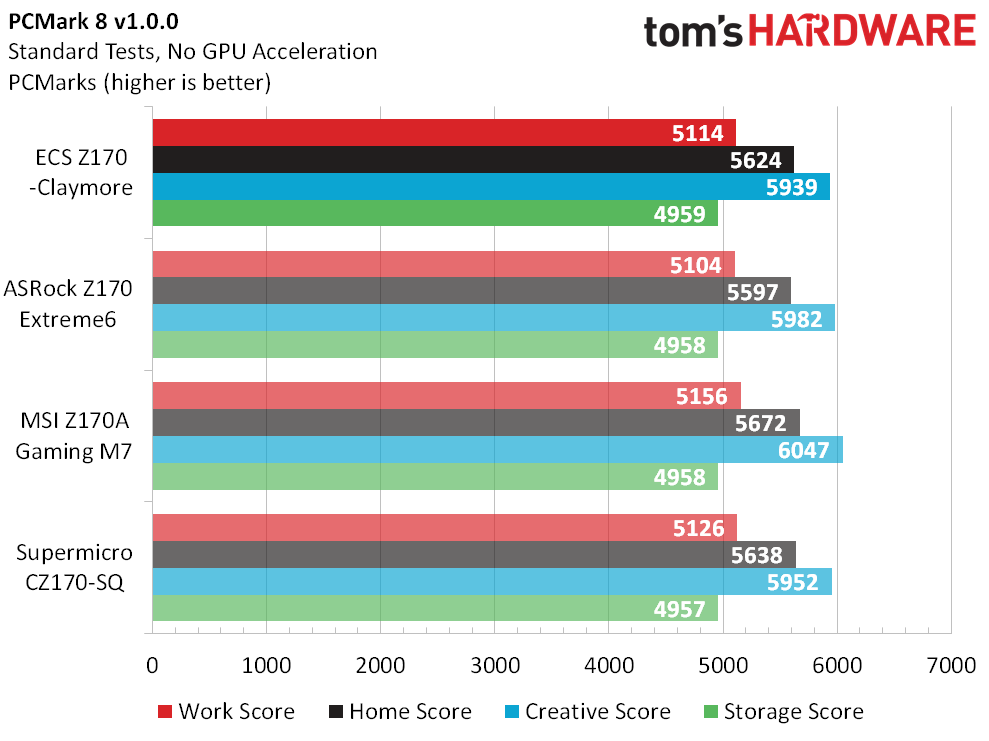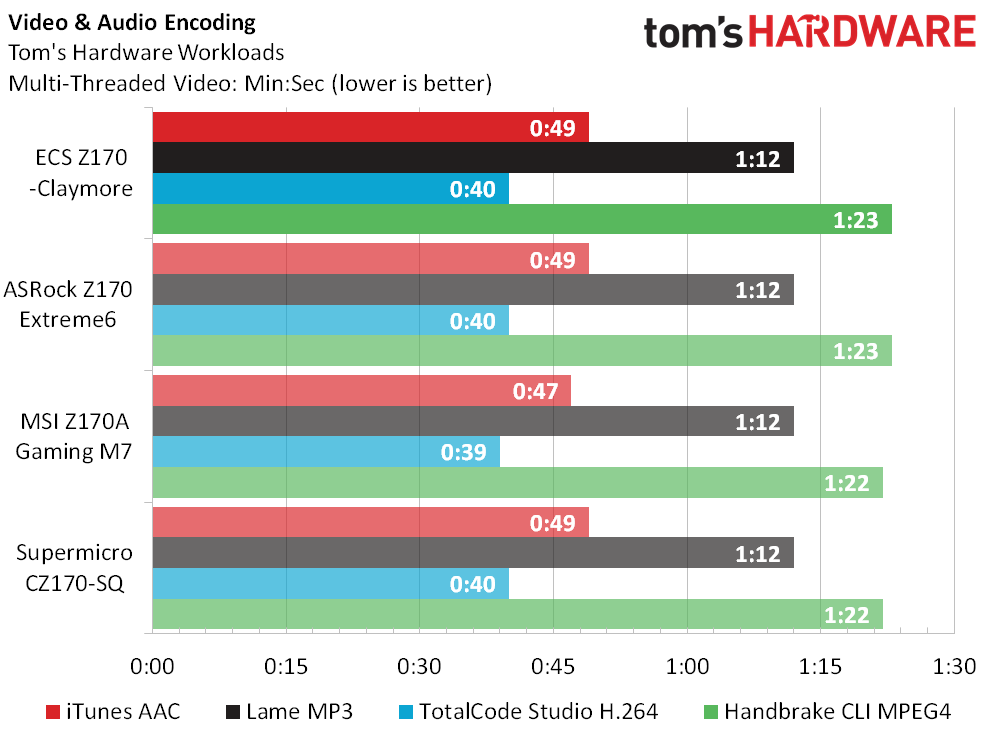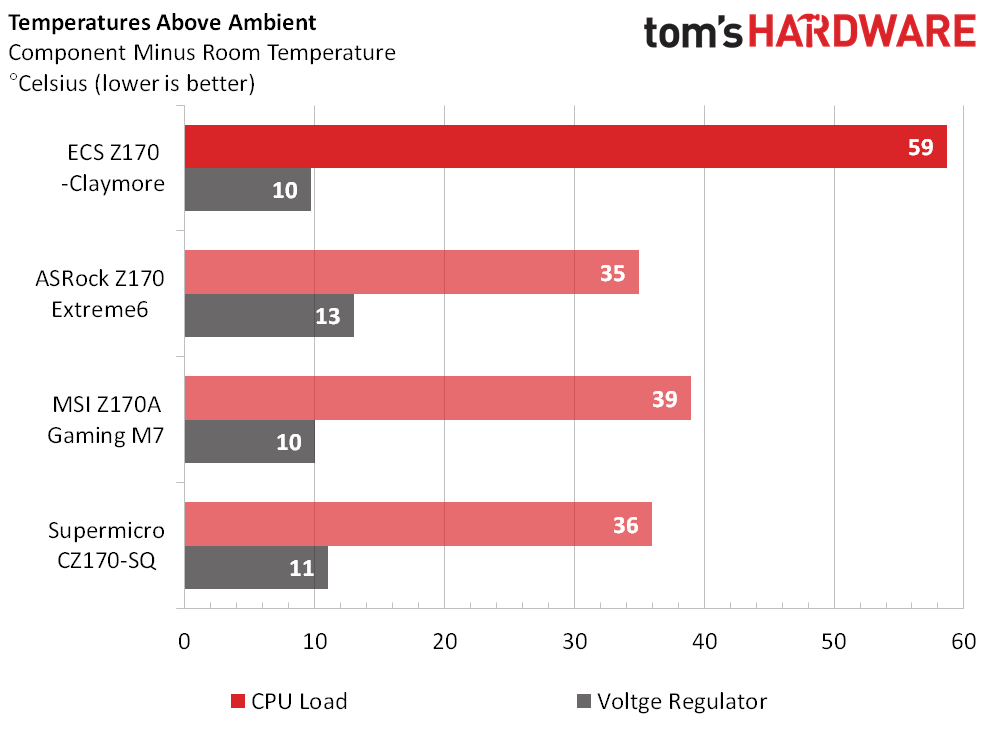ECS Z170-Claymore Motherboard Review
The Claymore leaves little doubt about ECS’ intent to stay in the enthusiast space, but how does it stack up to competitors?
Why you can trust Tom's Hardware
Test Results
Synthetics
The Z170-Claymore finished slightly down in 3DMark, but not by an amount that was noticeable in action scenes. A secondary examination with GPU-Z and CPU-Z showed that the top slot was continuously stuck in x8 mode, even though it has the required hardware to switch between x16-x0 and x8-x8 modes. The enhanced bandwidth of PCIe 3.0 should have been great enough to prevent even this small a difference, in theory.







The Z170-Claymore is in a dead heat with the top two competitors in memory bandwidth. All boards were tested using automatic settings, and the timing issues previously mentioned only occurred with “Manual” mode enabled.
Games




Perhaps it’s time for us to re-evaluate our performance expectations with PCIe 3.0 x8 mode? The Z170-Claymore falls slightly behind the pack in both Battlefield 4 and Far Cry 3, though not by a great enough margin to impact actual play.
Applications




None of the tested boards really stand out in non-gaming applications, proving mostly that they’re all pushing the same CPU speed. Had there been a large difference, we’d expect something was wrong with the winner (or loser).
Power, Heat And Efficiency
The Z170-Claymore consumes less power than its rivals at idle, which is good for efficiency and expected in a board that doesn’t have many third-party controllers tacked-on. On the other hand, it consumes far more power under load. We opened CPU-Z to see why and were startled by the report (which turned out to be wrong). ECS informed us of the problem with CPU-Z, suggested we use a different program, and said that the board was operating as intended.
That still left me scratching my head over the power reading. I got out the voltmeter and found that even though CPU-Z was up to 0.50V off at maximum (reports too high) and minimum (reports too low) loads, the actual voltage topped out around 1.50V at stock settings. That’s around 250 mV higher than other boards.
The higher voltage also affected peak CPU temperature, allowing it to reach 80 °Celsius during extended load tests. At least the motherboard’s voltage regulator stayed cool.
Get Tom's Hardware's best news and in-depth reviews, straight to your inbox.


A performance deficit of nearly 3% in games lead to an overall 0.7% drop in the average of all tests, which combines with a 16.6% higher-than-average power requirement to force a 14.8% loss of efficiency.
-
utroz Seriously where is the Display Port. HDMI is for TV"s not real monitors. I can use a passive adapter from DP to HDMI if I want to use a crappy TV as a monitor..Reply -
SinxarKnights Sorry ECS. I have used your boards in the past and they all died a horrible death for no apparent reason.Reply
Since I first spotted these MBs on Newegg, calling them LEET seems like they are spitting in my face. I actually thought it was a scam until I later learned they are ECS boards.
I don't know about others but when I look for a quality motherboard it better not have l337 in the title, it just reeks of some garbage you would try to market to very young children... or maybe that is the goal? -
bignastyid Atleast they named it right. Who is going to be surprised when something named Claymore blows up.Reply -
Crashman Reply
Every problem I've had with ECS has been firmware-related. I really don't expect it to "blow up".16572439 said:Atleast they named it right. Who is going to be surprised when something named Claymore blows up.
-
bignastyid Reply16572532 said:
Every problem I've had with ECS has been firmware-related. I really don't expect it to "blow up".16572439 said:Atleast they named it right. Who is going to be surprised when something named Claymore blows up.
It was more a figurative term, sounded better than die young. Which is what I have seen them do most often(a couple did have exploded capacitors), but this was years ago don't see them as often any more(thank god). Now of they made power supplies like their motherboards they probably would literally blow up. -
Crashman Reply
ECS has been doing OK on the hardware side since its first gaming brand launch 2005, but every time they get close to having a decent firmware they change it up and start over again.16572559 said:16572532 said:
Every problem I've had with ECS has been firmware-related. I really don't expect it to "blow up".16572439 said:Atleast they named it right. Who is going to be surprised when something named Claymore blows up.
It was more a figurative term, sounded better than die young. Which is what I have seen them do most often(a couple did have exploded capacitors), but this was years ago don't see them as often any more(thank god). Now of they made power supplies like their motherboards they probably would literally blow up.
-
Mac266 ReplyAtleast they named it right. Who is going to be surprised when something named Claymore blows up.
A Claymore is a large two-handed sword. -
Crashman Reply
OK, now using it that way would probably break it.16580242 said:Atleast they named it right. Who is going to be surprised when something named Claymore blows up.
A Claymore is a large two-handed sword.


